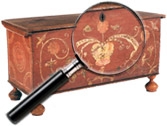|
|
Globe-Wernicke Barrister Bookcases
Barrister, or lawyer, bookcases are characterized by their stackable modular construction and glass paned lift-doors designed to keep books free of dust. The bookcases are found in as few as two and as many as seven stackable shelving units, usually in oak (plain or quarter-sawn), but occasionally in mahogany or imitation mahogany. Higher-grade units often have an Arts & Crafts flavored leading to the glass doors with beveled or colored glass [...] Click here to continue reading.
Gueridon
Gueridon has unclear origins, but the French word has come to mean something similar to “decorative candlestand.” When the word originally came into use, it tended to refer to a small table with a circular top and the distinctive feature of a central figural support. The figures were usually Moorish or Indian. The form evolved and gueridon continued to be applied to three-legged tables with figural-carved legs, and during the Louis XV and [...] Click here to continue reading.
Pietra Dura
Pietra dura (also pietre dure) is an Italian phrase, with pietra meaning “stone” and dura meaning “hard” or “durable.” While pietra dura is the preferred term (at least according to The Getty’s Art and Architecture Thesaurus at http://www.getty.edu/research/conducting_research/vocabularies/aat/), the terms micromosaic or Florentine mosaic are occasionally encountered. (Some find “micromosaic” to be a little objectionable, applying only to the “rougher” forms of the art produced for the tourist trade.)
Pietra dura is [...] Click here to continue reading.
Toupie Feet
Derived from the French word for top (as in a child’s toy spinning top), toupie feet are turned top-shaped forms having a larger turning in the middle, narrowing to a small radius turning at the bottom which forms the foot.
Reference note by p4A editorial staff, 05.09.
Connoisseurship Lesson: Gate-Leg Tables
American homes in the Pilgrim Century and early Colonial periods were most often quite modest in both size and furnishings. A typical household might have a bedstead, table, wardrobe and several benches or chairs. The heavy use of this furniture frequently resulted in substantial wear. This was especially true of early tables, which saw heavy use in a wide variety of functions. For this reason it was common for their [...] Click here to continue reading.
Connoisseurship Lesson: Butterfly Tables
In the decades following the great celebration of American’s Centennial in 1876 there was a resurgence of interest in American material goods of all types from the Colonial and Federal periods. Interest in early furniture was particularly strong, led by such entrepreneurs as Wallace Nutting. One of the most favored forms from this early period was the butterfly table, a smaller side or tavern table, usually with canted-legs and stretchers, [...] Click here to continue reading.
Fiche Hinges
The barrel form hinges found on the doors of French furniture and Louisiana case furniture of the Colonial period (1750-1803), are referred to as fiche hinges. The French word fiche when applied to hinges means a pin or a peg. It has other meanings including a slip of paper or small card. The tubular sturdy fiche hinges are usually made from brass or steel, and can be found in multiples or singles [...] Click here to continue reading.
Charles Greene & Henry Greene, Architects
Architects and furniture designers, Charles Sumner Greene (1868 to 1957) and his brother Henry Mather Greene (1870 to 1954) were born in Brighton, Ohio to old New England families. They moved to St. Louis in 1874 and enrolled at the Manual Training School of Washington University. They would complete their formal education in 1891 from the Massachusetts Institute of Technology in architecture and then began apprenticeships in Boston.
[...] Click here to continue reading.
The Classical Period, 1800 to 1840
Some may find the Classical Period of American furniture to be somewhat confusing as it overlaps that of the Federal Period. This confusion may be particularly acute among dealers and collectors of country American furniture, for while we do see many pieces of fine Federal furniture, we less frequently see examples of Classical furniture and, when we do, there is seldom anything country in its form or finish. [...] Click here to continue reading.
Modern Gothic Furniture
The term “modern Gothic” in the Decorative Arts refers to furniture and decorative objects with clean lines made from about 1870 to 1890. Also known as “art furniture” and “Queen Anne Revival”, depending on the creator, the pieces reflect the inspiration of the English “reform movement”. This movement reflected a change in taste away from the French inspired “ostentatious” highly carved Rococo Revival designs of the middle 19th century toward the [...] Click here to continue reading.
|
Recent Articles
- Charles Alfred Meurer – American Artist & Tromp L’Oeil Artist
- Sendak, Maurice – American Artist & Writer
- Godie, Lee – American Artist
- Davis, Vestie – American Artist
- Bartlett, Morton – American Artist
- Mackintosh, Dwight – American Artist
- Evans, Minnie Jones – African-American Artist
- Mumma, Ed (Mr. Eddy) – American Artist
- Nice, Don – American Artist
- Savitsky, John (Jack) – American Artist
- Gordon, Harold Theodore (Ted) – American Artist
- Dial, Thornton – African-American Artist
- Doyle Sam – American Artist
- Johnson, Lester Frederick – American Artist
- Finster, Howard – American Artist
|
|
